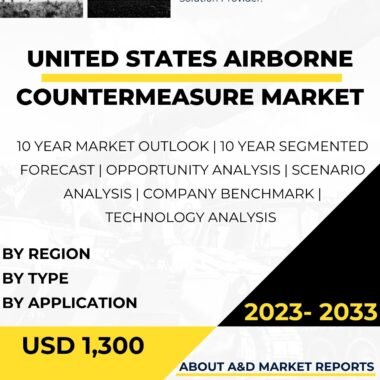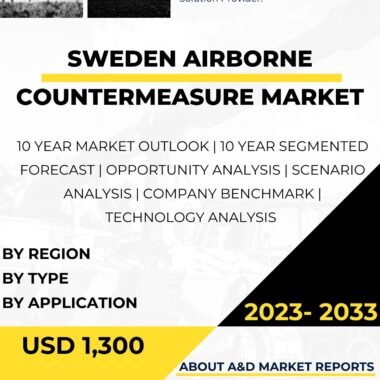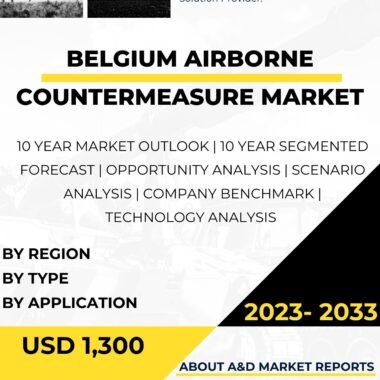Description
The Germany Airborne Countermeasure Market is a critical and dynamic segment within the country’s defense industry. It focuses on the development, production, and acquisition of advanced airborne countermeasure systems to enhance Germany’s air defense capabilities and protect its aerial assets from hostile threats, including missiles, anti-aircraft weapons, and electronic warfare attacks. Airborne countermeasures are essential defensive measures employed by military aircraft to disrupt and defeat enemy targeting and tracking systems, ensuring the survivability of the aircraft and its crew.
The adoption of airborne countermeasure systems in Germany is driven by several key factors. Foremost among them is the need to safeguard the country’s aerial assets from a wide range of threats in modern combat environments. As adversaries continue to develop and deploy sophisticated anti-aircraft weaponry and electronic warfare systems, the vulnerability of aircraft has increased, necessitating the deployment of advanced countermeasure systems to neutralize these threats effectively.
Moreover, the Germany Airborne Countermeasure Market has witnessed significant advancements in technology, including the development of cutting-edge electronic warfare systems, infrared countermeasure systems, and radar jamming technologies. These technological innovations have opened up new possibilities for airborne countermeasure systems, enabling German military aircraft to evade and defeat enemy threats with precision and efficiency.
The German government’s focus on enhancing defense capabilities and modernizing its military forces plays a pivotal role in driving the growth of the domestic Airborne Countermeasure Market. Germany recognizes the strategic importance of equipping its aircraft with state-of-the-art countermeasure systems to enhance their survivability and ensure operational effectiveness in contested airspace.
The Germany Airborne Countermeasure Market also benefits from partnerships and collaborations with international defense companies. Joint ventures, technology transfers, and knowledge-sharing agreements enable German defense manufacturers to access global expertise and best practices, accelerating the development and deployment of advanced airborne countermeasure systems.
A core objective of the Germany Airborne Countermeasure Market is to enhance the protection and survivability of military aircraft. Airborne countermeasure systems provide crucial defensive capabilities, including the ability to jam enemy radar systems, launch flares to divert incoming heat-seeking missiles, and deploy chaff to confuse radar-guided threats.
The adoption of airborne countermeasure systems offers several benefits for Germany’s defense forces. First and foremost, it improves the survivability of military aircraft in high-threat environments. By disrupting and neutralizing enemy targeting and tracking systems, airborne countermeasure systems significantly reduce the vulnerability of aircraft to anti-aircraft weapons and electronic warfare attacks.
Furthermore, airborne countermeasure systems contribute to the overall deterrence posture of the German Armed Forces. The presence of advanced countermeasure systems on German military aircraft sends a clear message to potential adversaries, showcasing the country’s commitment to protecting its aerial assets and deterring hostile actions.
Additionally, the Germany Airborne Countermeasure Market supports the growth of the domestic defense industry and fosters technological innovation. The development and production of airborne countermeasure systems require specialized engineering skills, advanced materials, and manufacturing capabilities. As the domestic defense industry invests in these areas, it fosters job creation, skill development, and economic growth.
However, the Germany Airborne Countermeasure Market also faces certain challenges. One significant hurdle is the cost associated with developing and acquiring advanced countermeasure systems. These cutting-edge defense technologies require substantial investments in research, development, and production, which may pose financial constraints for the defense budget.
Moreover, there are technical and operational considerations that need to be addressed when integrating airborne countermeasure systems into existing aircraft. Compatibility with various aircraft platforms, ensuring seamless integration with other onboard systems, and optimizing countermeasure performance in different operational environments are critical factors that require careful planning and testing.
Looking ahead, the Germany Airborne Countermeasure Market is expected to witness continued growth and innovation. As defense technology continues to evolve, airborne countermeasure systems will become more sophisticated, adaptable, and effective in countering emerging threats. The German government’s commitment to investing in advanced countermeasure capabilities and fostering collaboration with defense industry partners will be instrumental in driving the adoption and deployment of cutting-edge airborne countermeasure systems.
In conclusion, the Germany Airborne Countermeasure Market is a critical and rapidly evolving segment with significant implications for the country’s defense capabilities and military preparedness. With a focus on innovation, research, and collaboration, the German defense industry is poised to become a key player in harnessing the power of airborne countermeasure technology. Additionally, by adopting advanced countermeasure systems, Germany can enhance the protection and survivability of its military aircraft, thereby bolstering national security and maintaining its edge in aerial warfare. As airborne countermeasure technology continues to advance, the Germany Airborne Countermeasure Market will play a pivotal role in shaping the future of air defense capabilities in the country.




